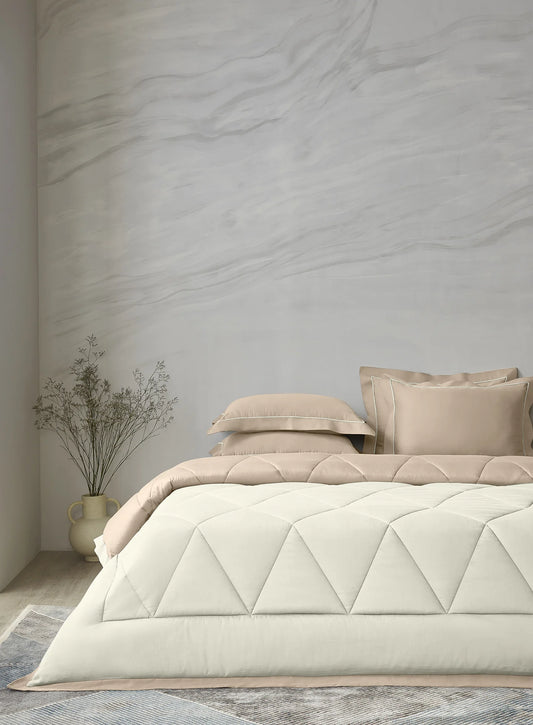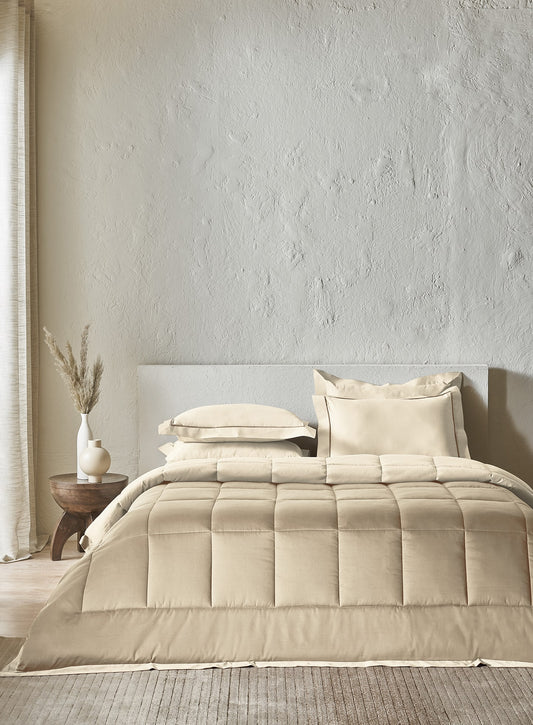The Importance of Choosing the Right Bedding for Cold Weather
As temperatures drop, our sleeping environment transforms. A cozy bed can be the difference between tossing and turning or slipping into a restful slumber. The right bedding does more than shield you from the chill; it provides a cocoon of warmth and comfort that rejuvenates your body and mind.
Bedding is critical in regulating body temperature, vital for quality sleep. When it’s too cold, your body expends energy trying to stay warm, disrupting the restorative phases of sleep. Proper bedding creates a thermally balanced environment, allowing your muscles to relax fully and your mind to drift into deep, uninterrupted rest.
Winter nights bring unique challenges. Regular bedding may not provide adequate insulation, leaving you vulnerable to the elements. Specialized cold-weather bedding uses advanced materials and thoughtful designs to trap heat without compromising breathability. This creates an ideal sleep sanctuary, even during the frostiest months.
Key Factors to Consider When Selecting Bedding for Cold Weather
The primary function of cold-weather bedding is to keep you warm. Look for materials with high thermal retention, such as wool or fleece. Consider the tog rating of comforters and duvets a higher tog means better insulation. Opt for bedding tailored to the climate of your region to ensure optimal warmth.
While warmth is essential, bedding must also allow for airflow. Overly insulating materials can cause overheating, leading to night sweats and discomfort. Fabrics like cotton blends or moisture-wicking synthetics strike a balance between warmth and breathability, keeping you cozy without stifling heat buildup.
Natural fabrics like wool and cotton are breathable and sustainable, offering timeless appeal. On the other hand, synthetic fabrics often boast enhanced durability and affordability. Each has its merits, and the right choice depends on your priority’s environmental friendliness, cost-efficiency, or ease of maintenance.
Top Fabric Choices for Cold-Weather Bedding
Flannel is a perennial favorite for its soft, brushed texture that traps body heat while remaining breathable. Its rustic charm and durability make it ideal for those seeking a traditional, homey feel during cold nights. Fleece, with its ultra-soft and lightweight properties, offers unmatched warmth. This synthetic material mimics wool’s insulating abilities while being more affordable and easier to care for. Perfect for those who crave indulgent comfort.
Wool is a natural powerhouse, excelling in thermal regulation. Its fibers trap air, creating a barrier against the cold while wicking away moisture. Wool dohar or duvets are excellent investments for enduring winters and offer a luxurious touch to any bed.
Though commonly associated with summer, cotton can hold its own during colder months. Heavier weaves, such as Egyptian or brushed cotton, provide warmth and comfort. Its breathability also makes it an excellent layering material.
Silk offers a unique combination of elegance and practicality. Its natural thermoregulatory properties keep you warm without overheating, and its smooth texture adds a touch of sophistication to any bedding ensemble.
Layering Your Bedding for Maximum Warmth
Sheets form the foundation of your bedding. Opt for flannel or jersey-knit sheets during winter for added warmth. These materials are soft against the skin and enhance the overall coziness of your bedding layers. Layering blankets creates pockets of trapped air that act as insulators. Start with a lightweight fleece blanket closest to your body, add a wool or cotton layer for bulk, and top with a heavy duvet or comforter. This layering technique keeps you warm without adding unnecessary weight.
When selecting a comforter, prioritize fill material and weight. Down-filled duvets are exceptionally warm, lightweight, and breathable, while synthetic alternatives offer hypoallergenic options. Ensure the duvet cover complements your aesthetic while adding an extra layer of protection.
Choosing the Right Pillows for Cold Nights
When the cold sets in, finding the right pillow can significantly enhance your sleeping experience. Pillows do more than cradle your head. they contribute to temperature regulation and overall comfort, making them an essential part of your winter bedding setup.
The material inside your pillow determines its warmth and breathability. Down-filled pillows are a classic choice for winter, offering exceptional insulation and a soft, cloud-like feel. Memory foam pillows, while not naturally warm, conform to your head and neck, reducing heat loss. For those seeking a vegan or hypoallergenic option, synthetic down alternatives provide a similar plushness without triggering allergies.
Heated pillows are a revelation for cold nights With built-in heating elements, they provide consistent warmth, eliminating the need for extra layers. Weighted pillows, on the other hand, offer a snug, comforting pressure that feels like a gentle hug, promoting relaxation and deep sleep. When paired with a soft pillowcase, these pillows become indispensable for combating winter chills while enhancing your overall sleep quality.
Quilts, Throws, and Bedspreads
Winter weather bedding setup is not complete without the finishing touches provided by quilts, throws, and bedspreads. These versatile layers not only boost warmth but also add texture and style to your bed. Quilts are a timeless addition to winter bedding. With their layered construction, they trap air, creating a barrier against the cold. Heavier quilts filled with wool or down are particularly effective for frigid nights.
Throws are the unsung heroes of chilly evenings. Drape one over your shoulders as you relax or layer it at the foot of your bed for added warmth. Materials like cashmere, fleece, or knit wool combine luxury and practicality. Available in a range of colors and patterns, throws allow you to express your personality while keeping the cold at bay.
Bedding Accessories to Enhance Warmth
Mattress toppers provide an additional layer of insulation beneath you, preventing heat loss to the mattress. Memory foam toppers are particularly effective, molding to your body and retaining warmth. Wool toppers are another excellent option, offering natural breathability and a touch of luxury.
Heated mattress pads take warmth to the next level. With adjustable heat settings, they allow you to pre-warm your bed before slipping under the covers. Modern designs are energy-efficient and often include dual controls, making them perfect for partners with different temperature preferences. While primarily decorative, bed skirts and dust ruffles can subtly contribute to warmth. By covering the space beneath your bed, they reduce drafts and help retain heat around your sleeping area.
Eco-Friendly Options for Cold-Weather Bedding
As awareness grows about the impact of consumer choices, eco-friendly bedding options have become increasingly popular, offering warmth without compromising on sustainability. Natural materials like organic cotton, bamboo, and recycled wool provide exceptional warmth while reducing your environmental footprint. These materials are often free from harmful chemicals, making them safe for you and the planet. Innovations in textile technology have also led to eco-friendly synthetic alternatives that mimic the properties of traditional down or fleece.
Several brands are setting the standard for sustainable winter bedding. Companies like Coyuchi, Avocado Green, and Parachute offer high-quality, ethically sourced options that prioritize both comfort and environmental responsibility. From carbon-neutral production to recyclable packaging, these brands make it easy to create a warm, eco-conscious sleep environment.
How to Maintain and Care for Your Winter Bedding
Winter bedding is an investment in comfort and warmth. Proper maintenance not only prolongs its lifespan but also ensures that it remains as cozy and effective as the day you first snuggled into it. Caring for your bedding requires attention to fabric types, seasonal storage, and regular upkeep.
Winter bedding, often made of plush or heavy fabrics like wool, flannel, or fleece, demands gentle care. Always begin by checking the care labels for manufacturer instructions. Use a mild detergent to preserve the softness and integrity of delicate materials. Cold or lukewarm water is ideal for preventing shrinkage and maintaining vibrant colors. For down-filled comforters and duvets, opt for a professional cleaner or wash them at home in a large-capacity machine using a gentle cycle.
When spring arrives, it’s time to safely store your winter bedding to ensure it’s ready for the next cold season. Begin by thoroughly cleaning all items to prevent odors and pest infestations. Fold quilts and comforters neatly and place them in breathable storage bags. Avoid vacuum-sealing down items, as it can compress and damage their filling.
Budget-Friendly Tips for Winterizing Your Bedding
Creating a warm and inviting bed doesn’t have to strain your wallet. With a little creativity and savvy shopping, you can prepare your bed for winter on a budget. Repurposing items you already own can add warmth to your bed without spending a dime. Layer an old fleece blanket between your sheet and mattress for added insulation. Sew together fabric scraps to create a custom patchwork quilt that adds a personal touch and an extra layer of heat.
Scour sales and clearance sections at department stores for seasonal markdowns on winter bedding. Thrift stores and online marketplaces often feature gently used blankets, quilts, and duvets at a fraction of the original cost. Scour sales and clearance sections at department stores for seasonal markdowns on winter bedding. Thrift stores and online marketplaces often feature gently used blankets, quilts, and duvets at a fraction of the original cost. Brands like IKEA and Target offer affordable yet high-quality options that balance comfort and durability. Keep an eye out for coupons, end-of-season discounts, and warehouse sales to snag premium bedding at a lower price.
FAQs About Cold-Weather Bedding
When winter arrives, so do questions about how to maximize comfort and efficiency with your bedding choices. Here are some common queries and their answers. While some bedding is marketed as "all-season," it may not always provide optimal comfort in extreme temperatures. Layering lightweight blankets over a mid-weight comforter can offer flexibility for year-round use. However, for regions with harsh winters, investing in specialized cold-weather bedding ensures better warmth and sleep quality.
For bone-chilling climates, down-filled duvets and wool blankets are unparalleled. They provide exceptional insulation without feeling overly heavy. Pair them with flannel sheets for added warmth. Synthetic options like microfiber and fleece are great for their affordability and hypoallergenic properties, making them suitable for even the coldest nights.
The Role of Room Temperature in Bedding Choices
Your bedroom’s temperature can significantly influence your bedding’s effectiveness and your overall sleep quality. Striking the right balance between room temperature and bedding layers is crucial. A slightly cooler room with warm bedding promotes deep sleep, as your body naturally lowers its temperature during rest. Use a humidifier to combat the dryness of heated air and add moisture to the environment, preventing discomfort and ensuring restful slumber.
Experts recommend maintaining your bedroom temperature between 60-67°F (15-19°C) for optimal sleep. Adjust your bedding layers accordingly, using lightweight throws or blankets if you feel chilly. Avoid overheating the room, as excessive warmth can lead to restless nights and disrupted sleep cycles.
Personalizing Your Winter Bedding Experience
Winter bedding isn’t just about staying warm. it’s an opportunity to create a haven that reflects your personality and meets your unique needs. By adding thoughtful touches and tailoring your bedding setup, you can transform your sleep environment into a sanctuary of comfort and style.
Aromatherapy can elevate your winter bedding experience by infusing your sleep space with soothing scents. Essential oils like lavender, chamomile, and sandalwood are known for their calming properties, helping to reduce stress and promote deeper sleep. Use a linen spray to lightly mist your pillows and sheets before bedtime, or place a diffuser on your nightstand for a continuous release of relaxing aromas.
Your lifestyle plays a significant role in determining the best bedding setup for your winter needs. Are you someone who enjoys lounging in bed with a book or binge-watching shows? Opt for a plush throw and oversized pillows for a cozy, indulgent feel. If you’re a minimalist, sleek, neutral-toned bedding with clean lines might suit your aesthetic. For families with pets or kids, durability is key choose machine-washable materials like microfiber or heavy-duty cotton that can withstand frequent cleaning.
Wrapping Up: Creating the Ultimate Cold-Weather Sleep Sanctuary
As the nights grow colder, your bedding becomes more than just a necessity. it’s the heart of your home’s comfort. With a few thoughtful additions and a focus on personalization, you can curate a sleep space that offers unparalleled warmth and tranquility.
From flannel sheets to down-filled duvets, winter bedding is all about layering the right materials for maximum insulation and comfort. Flannel provides a soft, cozy foundation, while fleece and wool deliver superior warmth. Down comforters, with their unmatched ability to trap heat, remain a timeless choice for cold-weather comfort. Don’t forget the finishing touches: quilts, throws, and even heated mattress pads can elevate your setup to new heights of coziness.
To create the ultimate winter haven, focus on layering and texture. Start with high-quality sheets and add a thick comforter or duvet. Incorporate a mix of blankets in varying weights and materials to cater to fluctuating temperatures. Pile on decorative pillows and a chunky knit throw for an inviting aesthetic.








